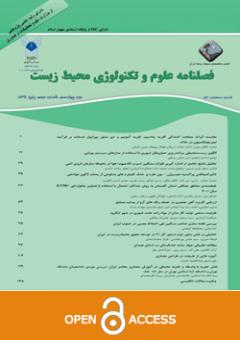Investigating the effect of land use in flooding potential of urban area (Case Study: region 1 in Tehran)
Subject Areas : مدیریت ، برنامه ریزی و آموزش محیط زیستMahdieh Saadat 1 , Bahram Malek mohammadi 2
1 - Master in environmental planning, University of Tehran. *(Corresponding Author)
2 - Associated professor of planning, management and education of environment, University of Tehran.
Keywords: : Runoff management, Urban flooding, Flood potential, Curve Number method, Land use. ,
Abstract :
Background and Objective: Tehran is one of the cities that are continuously exposed to flooding. High density and high volume of impervious surfaces in urban runoff as well as being at the foot of the mountain are the main reasons for potential flooding in Tehran. Therefore, identifying prone areas to urban flooding is considered the most important measures in reducing losses and efficient management.
Material and Methodology: In this study, the flood potential of region 1 in Tehran using the curve number method was evaluated in ArcMap software.
Findings: The curve number and infiltration map of the area was prepared by combining data and according to the land use. Then, using the maximum daily precipitation zoning maps and formulas, runoff for different return periods were calculated for the area.
Discussion and Conclusion: The results show that for the precipitation with return period of 5-year and 10-year, about 90 percent of area has high and very high flooding potential. These measures in return periods of 25 and 50 years will be the top 95 percent. Also, in the return periods of 25 and 50 years, all the areas of urban flood potential are moderate to high and area with little flood potential are not found. Furthermore, in areas where the density residential and parking is more, the cumulative effect of impervious surfaces is increased flooding potential.
1. Novotny V. Non point Pollution and Urban Stormwater Management: CRC Press; 1995.
2. Ghanbari Adivi, M. Investigating the atmospheric performance of local gardens in Tehran in order to design for the removal of surface runoff pollutants. Master thesis of Sharif University of Technology, 2011. (In Persian)
3. Tanski J. Stormwater runoff. Best management practices for marinas. A guide for operators. 2007.
4. Vereecken H, Kemna A, Münch HM, Tillmann A, Verweerd A. Aquifer characterization by geophysical methods. Encyclopedia of Hydrological Sciences. 2005.
5. Igulu, B. S., & Mshiu, E. E. The Impact of an Urbanizing Tropical Watershed to the Surface-Runoff. Global Journal of Environmental Science and Management,2020, 6, 245-260.
6. Cao, W. T. et al. Increasing global urban exposure to flooding: An analysis of long-term annual dynamics. Sci. Total Environ. 817,10. https://doi.org/10.1016/j.scitotenv.2022.153012 (2022).
7. He, C. et al. Future global urban water scarcity and potential solutions. Nat. Commun. 12, 4667. https://doi.org/10.1038/s41467- 021-25026-3 (2021).
8. Abass, K., Adanu, S. K., & Agyemang, S. (2018). Peri-Urbanization and Loss of Arable Land in Kumasi Metropolis in Three Decades: Evidence from Remote Sensing Image Analysis. Land Use Policy, 72, 470-479. (In Persian)
9. Sillanpää N, Koivusalo H. Impacts of urban development on runoff event characteristics and unit hydrographs across warm and cold seasons in high latitudes. Journal of Hydrology. 2015;521:328-40.
10. Alshammari, E., Rahman, A. A., Rainis, R., Seri, N. A., & Fuzi, N. F. A. (2023). The Impacts of Land Use Changes in Urban Hydrology, Runoff and Flooding: A Review. Current Urban Studies, 11, 120-141.
11. Zhan X, Huang M-L. ArcCN-Runoff: an ArcGIS tool for generating curve number and runoff maps. Environmental Modelling & Software. 2004; 19(10):875-9.
12. Sarangi A, Singh D, Singh A. Evaluation of curve number and geomorphology-based models for surface runoff prediction from ungauged watersheds. Current science. 2008; 94(12):1620.
13. Gitika T, Ranjan S. Estimation of Surface Runoff using NRCS Curve number procedure in Buriganga Watershed, Assam, India-A Geospatial Approach. International research journal of earth sciences, 2 (5), 1. 2014;7.
14. Hamdami, Q. Shiday Kirkej, A. Akbari Majder, H. Preparation of curve number map of Marawa Tepe area using geographic information system. Protection and exploitation of natural resources, 1(3), 2012. (In Persian)
15. Nosrati, K. Ahmadi, M. Tharvati, M. Marzbani, M. Determining the effective factors in flood potential of Darehshahr watershed based on homogeneous hydrological areas. Geographical analysis of space, 3, 2014. (In Persian)
16. Zistab Consulting Engineers Co. Studies on the operationalization of the comprehensive plan of surface water management and the preparation of plans for the improvement of rivers and canals in one area of Tehran municipality, 2013. (In Persian)
17. Vice President of Planning and Urban Development of Tehran Municipality. Operational plan of Tehran city, 2014. (In Persian)
18. Mishra S, Tyagi J, Singh V, Singh R. SCS-CN-based modeling of sediment yield. Journal of Hydrology. 2006;324(1):301-22.
19. Kumar PS, Babu MRK, Praveen T. Analysis of the Runoff for Watershed Using SCS-CN Method and Geographic Information Systems. Analysis. 2010;2(8):3947-654.
20. Mahdavi, M. Applied Hydrology: University of Tehran, 2011. (In Persian)
21. McCuen RH. Hydrologic analysis and design: Prentice-Hall Englewood Cliffs, NJ; 1989.


